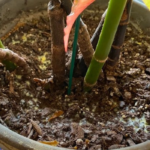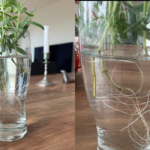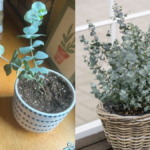Rotate indoor pots for even growth is one of the easiest and most effective habits every plant lover should follow. Many people feel their indoor plants grow on one side, lean towards light, or look uneven even after proper watering and feeding. The simple solution is to rotate the pot regularly. In this guide, I am sharing my personal gardening experience and explaining why rotation is important, how often you should rotate your indoor plants, and how this small habit can improve your plant’s overall health.
I started indoor gardening many years ago, first with money plants and snake plants inside my room. Slowly, I noticed that the side of the plant that faced the window always grew faster and looked greener. The back side remained dull and small. After some trials, I realised that rotating indoor pots helps plants receive equal sunlight, resulting in better shape, stronger stems, and balanced growth. Now this is a regular part of my care routine, and in this post, I will share everything I learned.
IN THIS ARTICLE
Why Rotate Indoor Pots?
Indoor plants mainly depend on indirect sunlight, which mostly comes from one direction—for example, a window or balcony door. When plants get light from just one side, they automatically bend or lean towards the source of light. This natural movement is called phototropism.
Here is why rotating indoor pots is so important:
- Balanced Growth: When all sides of the plant get equal light, the growth becomes uniform.
- Stronger Stems: Plants do not need to stretch too much while searching for light, so stems remain strong and straight.
- Better Leaf Color: Balanced sunlight creates rich green leaves on all sides.
- Healthy Structure: Rotating prevents the plant from becoming one-sided or top-heavy.
- Improved Air Circulation: When you rotate pots, all sides get exposure, reducing fungal risks.
- Better Looks: Your indoor plant looks fuller, rounder, and beautifully shaped.
From my personal experience, plants like Areca Palm, Snake Plant, ZZ Plant, Peace Lily, and Money Plant show the biggest improvement after rotation.
My Personal Experience with Rotate Indoor Pots for Even Growth
I remember my Areca Palm near the living room window. The side facing the window was tall and bright, but the other side was small and dull. I thought maybe fertilizer was not enough. But when I rotated the pot slowly every few days, in just 2–3 weeks I saw noticeable changes.
- The shorter side started catching up
- Leaf color became uniform
- Overall plant shape improved
- Growth became straight, not leaning
This simple habit changed the look and health of my indoor garden. Since then, rotating pots is a non-negotiable weekly routine for me.
How Often Should You Rotate Indoor Pots?
There is no strict rule, but from my gardening experience, these timings work best:
- Every 5–7 days for fast-growing indoor plants
- Every 10–15 days for slow-growing plants
- Every watering day is also a good reminder
- Quarter turn (90 degrees) each time is ideal
Remember: Do not rotate suddenly or harshly. Always rotate slowly so that the plant doesn’t stress.
Tips for Rotating Indoor Pots Properly
Here are simple but important tips to follow:
- Rotate gently to avoid breaking stems or damaging roots.
- Watch plant behavior—some plants may need more or less rotation depending on available light.
- Mark pot position with a small line if it helps you remember the previous direction.
- Keep sunlight direction in mind and adjust rotation accordingly.
- Avoid rotating flowering plants too often because some blooms may face stress.
- After repotting, avoid rotation for 2–3 weeks until the plant settles.
Which Plants Need Rotation the Most?
From my personal garden:
Fast-benefit plants
- Money Plant
- Pothos
- Peace Lily
- Syngonium
- Philodendron
Moderate-benefit plants
- Snake Plant
- ZZ Plant
- Rubber Plant
- Spider Plant
Low-rotation-needed plants
- Cactus
- Succulents
- Jade Plant
These slow growers do not need frequent rotation but still benefit from occasional adjustments.
Signs Your Indoor Plant Needs Rotation
Watch for these symptoms:
- Plant leaning towards one direction
- Taller growth on only one side
- Leaves facing only the window
- One side green and bright, the other pale
- Pot feels unbalanced
- Overall shape looks uneven
If you see these signs, rotate the plant and observe changes over the next few weeks.
Additional Care Tips to Support Even Growth
Rotating is important, but combining it with good care gives the best results.
1. Provide Stable Light
Place plants where they get consistent indirect sunlight. Sudden shifts confuse plants.
2. Maintain Proper Watering
Plants also bend due to stress. Keep soil evenly moist based on plant needs.
3. Use Good Potting Mix
A light, airy potting mix helps roots grow evenly.
4. Clean the Leaves
Dust blocks sunlight. Cleaning improves photosynthesis.
5. Use Proper Pot Size
If roots are crowded, growth on one side may slow down.
How Rotation Helps Indoor Decor
Indoor plants become the center of attraction when they look balanced and full. Rotating pots:
- Improves plant symmetry
- Makes indoor corners look brighter
- Creates a professional, well-maintained look
- Enhances the overall aesthetic of your home
A healthy, evenly grown plant always adds beauty to your indoor space.
Conclusion
Rotate indoor pots for even growth is one of the easiest plant care habits you can follow. With simple weekly rotation, your plants receive equal light from all sides, which leads to strong, balanced, and beautiful growth. From my personal gardening experience, this small habit has changed the health and look of my entire indoor garden. If you want fuller, greener, and perfectly shaped indoor plants, start rotating your pots regularly—it truly makes a big difference.
DAY 1 :- Check Soil Moisture Before Watering – with my experience
Day 2 :-Give Morning Sunlight to All Outdoor Plants: My Experience











